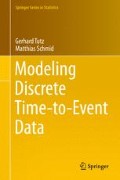Abstract
Basic concepts of the modeling of discrete time-to-event data are considered. In particular the discrete hazard or intensity function, which represents the conditional probability that an event occurs at time t given it has not yet occurred, is introduced. Another feature that makes modeling time-to-event data special is censoring, which means that the exact time of the occurrence of an event is not known. Although it is natural to consider time as a continuous variable, observations frequently are on a discrete time scale, either because measurements are intrinsically discrete or because observations are available only in a grouped form. Several examples are given that are used in later chapters.
Access this chapter
Tax calculation will be finalised at checkout
Purchases are for personal use only
References
Andersen, P. K., Borgan, O., Gill, R., & Keiding, N. (1993). Statistical models based on counting processes. New York/Berlin: Springer.
Box-Steffensmeier, J. M., & Jones, B. S. (2004). Event history modeling: A guide for social scientists. New York: Cambridge University Press.
Brüderl, J., Preisendörfer, P., & Ziegler, R. (1992). Survival chances of newly founded business organizations. American Sociological Review, 57, 227–242.
Cameron, A. C., & Trivedi, P. K. (2005). Microeconometrics: Methods and applications. Cambridge: Cambridge University Press.
Croissant, Y. (2015). Ecdat: Data sets for econometrics. R package version 0.2-9. http://cran.r-project.org/web/packages/Ecdat/index.html
Fleming, T. R., & Harrington, D. P. (2011). Counting processes and survival analysis. New York: Wiley.
Gerds, T. A. (2015). pec: Prediction error curves for survival models. R package version 2.4.7. http://cran.r-project.org/web/packages/pec/
Hastie, T., & Tibshirani, R. (1990). Generalized additive models. London: Chapman & Hall.
Huinink, J., Brüderl, J., Nauck, B., Walper, S., Castiglioni, L., & Feldhaus, M. (2011). Panel analysis of intimate relationships and family dynamics (pairfam): Conceptual framework and design. Journal of Family Research, 23, 77–101.
Jenkins, S. P. (2004). Survival analysis. Unpublished manuscript, Institute for Social and Economic Research, University of Essex. http://www.iser.essex.ac.uk/teaching/degree/stephenj/ec968/pdfs/ec968lnotesv6.pdf
Joergensen, H. S., Nakayama, H., Reith, J., Raaschou, H. O., & Olsen, T. S. (1996). Acute stroke with atrial fibrillation - the Copenhagen Stroke Study. Stroke, 27, 1765–1769.
Jones, B. (1994). A Longitudinal Perspective on Congressional Elections. Ph.D. thesis, State University of New York at Stony Brook.
Kalbfleisch, J. D., & Prentice, R. L. (2002). The statistical analysis of failure time data (2nd ed.). New York: Wiley.
Klein, J. P., & Moeschberger, M. L. (2003). Survival analysis: Statistical methods for censored and truncated data (2nd ed.). New York: Springer.
Lancaster, T. (1992). The econometric analysis of transition data. Cambridge: Cambridge University Press.
Lawless, J. F. (1982). Statistical models and methods for lifetime data. New York: Wiley.
McCall, B. P. (1996). Unemployment insurance rules, joblessness, and part-time work. Econometrica, 64, 647–682.
Nauck, B., Brüderl, J., Huinink, J., & Walper, S. (2013). The German Family Panel (pairfam). GESIS Data Archive, Cologne. ZA5678 Data file Version 4.0.0. doi:10.4232/pairfam.5678.4.0.0.
Scheike, T., & Jensen, T. (1997). A discrete survival model with random effects: An application to time to pregnancy. Biometrics, 53, 318–329.
Welchowski, T., & Schmid, M. (2015). discSurv: Discrete time survival analysis. R package version 1.1.1. http://cran.r-project.org/web/packages/discSurv
Author information
Authors and Affiliations
Rights and permissions
Copyright information
© 2016 Springer International Publishing Switzerland
About this chapter
Cite this chapter
Tutz, G., Schmid, M. (2016). Introduction. In: Modeling Discrete Time-to-Event Data. Springer Series in Statistics. Springer, Cham. https://doi.org/10.1007/978-3-319-28158-2_1
Download citation
DOI: https://doi.org/10.1007/978-3-319-28158-2_1
Published:
Publisher Name: Springer, Cham
Print ISBN: 978-3-319-28156-8
Online ISBN: 978-3-319-28158-2
eBook Packages: Mathematics and StatisticsMathematics and Statistics (R0)

